Sorry, Astronomers Haven’t Found The Brightest Quasar In The Entire Universe
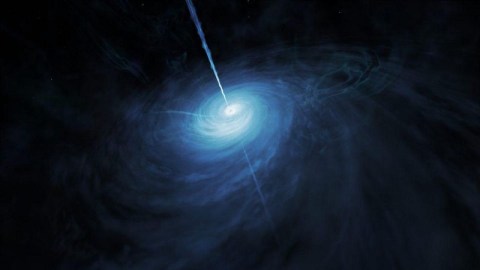
With an assist from Einstein’s gravity and the power of the Hubble Space Telescope, it’s the brightest quasar we’ve ever discovered.
In astronomy, there are two types of questions to answer: easy ones and hard ones. The easy questions involve nearby objects that are plentiful and easy to see; the hard ones involve distant objects that are rare and difficult to find. In many ways, the biggest questions of all involve determining what’s happening at the greatest cosmic extremes.
In a spectacular new find, astronomers have announced a record-shattering quasar in the early Universe: brighter than 600 trillion Suns. With its light coming to us from 13 billion years ago — just 800 million years after the Big Bang — its brightness implies that it’s powered by a black hole of 10 billion times the mass of our Sun.
But that conclusion is entirely wrong. It’s a quirk of Einstein’s relativity that’s tricking us, and we understand exactly why.
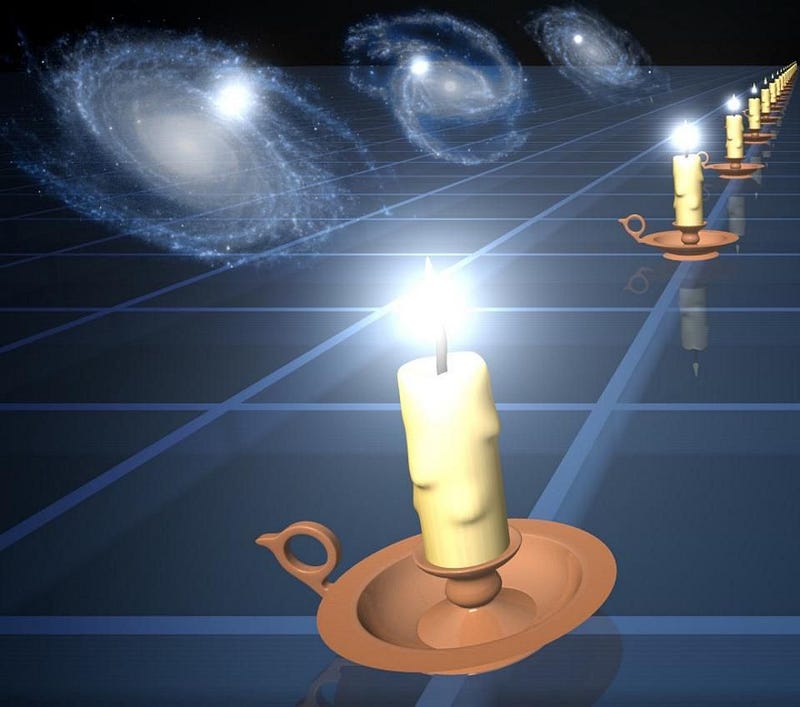
Imagine that you’ve got a bright light bulb. As you turn on the switch, it heats up its filament and shines brilliantly as powered by a standard number: 100 watts. You can stand a certain distance away from it, and predict exactly how bright it should appear. And this works the other way as well: if you can measure its distance and how bright it appears, you can infer exactly how intrinsically luminous it is.
But there’s a caveat to this line of thinking. You have to make sure that nothing is magnifying that light you’re seeing from your location in space. If you were to view this light bulb through a magnifying glass, you’d still get the distance measurement right, but you’d measure an apparent brightness that was artificially enhanced. The greater the magnifying power of your lens, the greater the artificial enhancement. If you tried to infer how intrinsically luminous your light bulb truly was, you’d be biased towards an incorrect answer, with higher magnifications biasing your results by larger amounts.
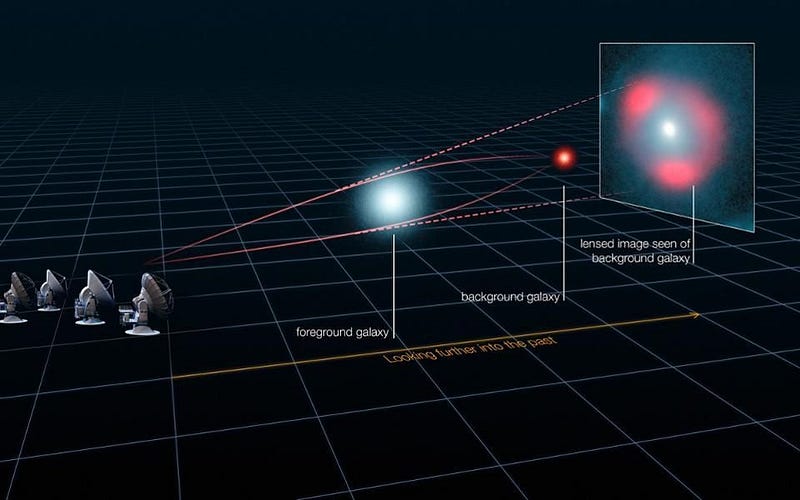
There aren’t magnifying glasses that naturally occur in space, but there is the very real phenomenon of gravitational lensing. When you’re looking at a distant object in the Universe, there’s the very real possibility of having a large mass existing along your line-of-sight to whatever it is you’re observing.
In Einstein’s relativity, mass causes the fabric of spacetime to curve, with greater masses inducing greater curvature. Light from a distant object that passes through a region of severely-curved spacetime will have its path distorted. If the distortion is significant enough, it can cause a variety of effects, including a stretching of the observed image, the creation of multiple images, and a large magnification of the light originating from the source.
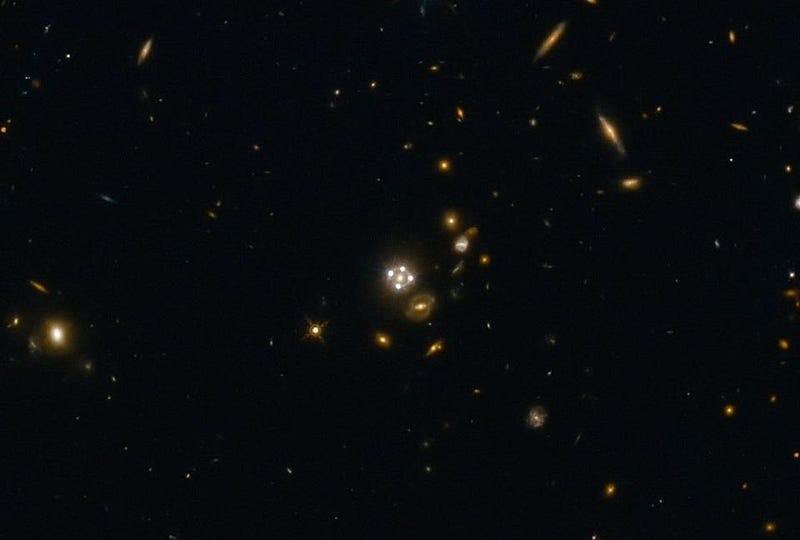
When it comes to the brightest objects in the ultra-distant Universe, we don’t use light bulbs. We don’t even use stars, galaxies, or supernovae; at such great distances, the only individual objects that can be seen in great numbers are quasars. Shortly after the Big Bang, the Universe formed stars for the first time, leading to black holes, mergers, and galaxies. As time ticked by, eventually the first supermassive black holes appeared at the centers of these young galaxies.
These black holes, when their host galaxies undergo large bursts of star formation, can accrete and devour large amounts of matter. As they do, the black holes grow, and the regions surrounding them emits large amounts of electromagnetic radiation, from the radio portion of the spectrum all the way up to the X-ray. Based on the radiation we observe, we can reconstruct all sorts of properties of these quasars and the galaxies they inhabit.
This newly-identified quasar is named J043947.08+163415.7, which we’ll call J0439 for short. It was discovered in a wide-area survey in 2017, and last year received follow-up observations from Hubble. And — just like you’d hope for with a light bulb — we were able to measure the distance and brightness of this object.
We can measure to very high precision how far away this quasar is, and get a value by applying what we know about the expanding Universe: 28.1 billion light years distant.
We can measure to very high precision how bright the quasar appears by collecting its light, and that gives us a direct measurement of apparent brightness.
And by putting those two figures together, we get that figure for the intrinsic luminosity of the quasar: 600 trillion times the brightness of the Sun.
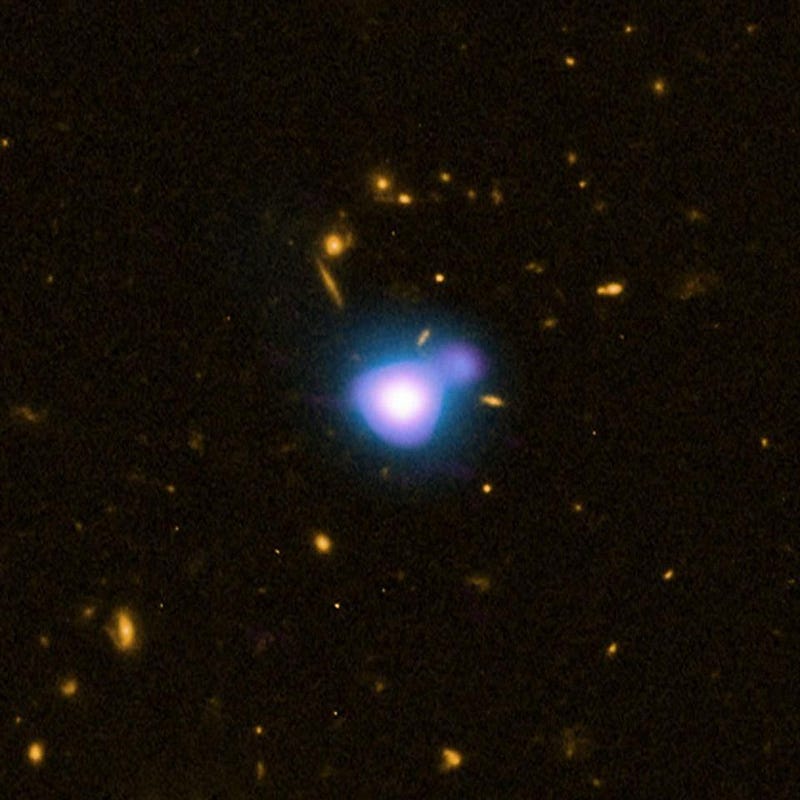
If that were true, this object would be by far the brightest thing we detected at such great distances. We presently know of hundreds of quasars found at similarly extreme distances, which range in brightness from a few trillion to perhaps 300 trillion times the luminosity of the Sun. So this new quasar, J0439, is now more than twice as luminous as the next-brightest one. Some are even contending that it may be the brightest quasar in the early Universe.
To give you an idea of how extreme such a quasar would be, we can infer a mass for its central black hole based on its brightness: 10 billion solar masses. We can infer a star-formation rate for the galaxy that houses it: 10,000 solar masses worth of new stars per year.
By comparison, our Milky Way has a supermassive black hole of only 4 million solar masses, and forms less than 1 solar mass worth of new stars each year.
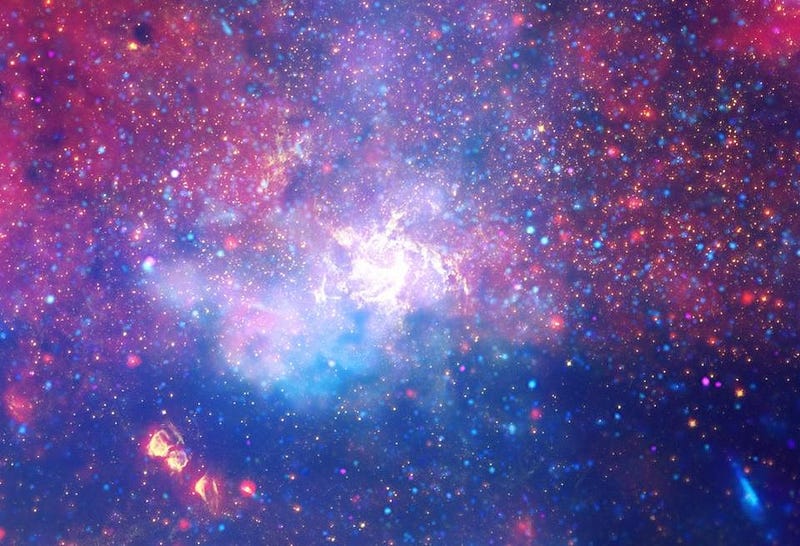
There have been approximately 500 quasars discovered that come to us from very early times: when the Universe was less than 1.2 billion years old. None are this bright, have black holes so massive, or imply star-formation rates that are so great. If this quasar were as bright as these observations imply, it might well be the most extreme object in the entire Universe.
But it’s not true. The quasar J0439 isn’t 600 trillion times as luminous as our Sun, and definitely isn’t the brightest quasar in the Universe. Instead, J0439 shows the telltale signs of gravitational lensing, which might be magnifying it by as much as a factor of 50.
Instead of being 600 trillion times as luminous as our Sun, it might only be 10–12 trillion times as luminous, which would actually make it one of the faintest quasar ever detected at such a great distance.
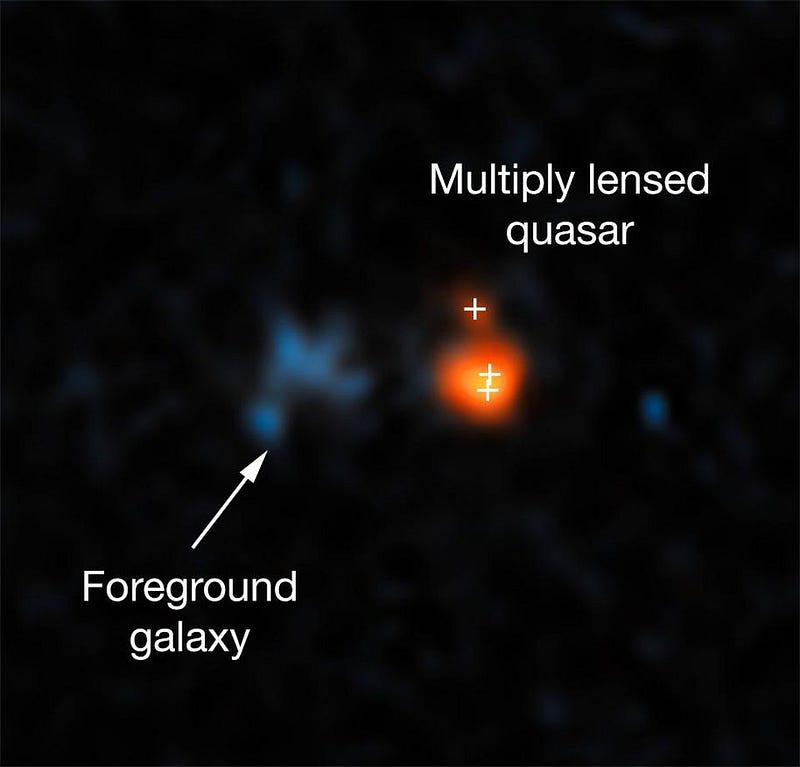
The lensing signatures are completely unambiguous and inescapable. Multiple images were resolved in the Hubble data, as observations showed the existence of three separate images for J0439. The existence of a foreground galaxy, offset by just the necessary angular difference, is clearly visible as well, revealing a source for gravitational lensing.
The best interpretation of this data is that the quasar may be sending light from 13 billion years ago, but approximately halfway between ourselves and that quasar, an interloping galaxy is curving space severely. When we reconstruct what must be present to explain these observations, we conclude that this isn’t the brightest quasar detected at such great distances; it’s the first quasar to be gravitationally lensed in the farthest reaches of the Universe.
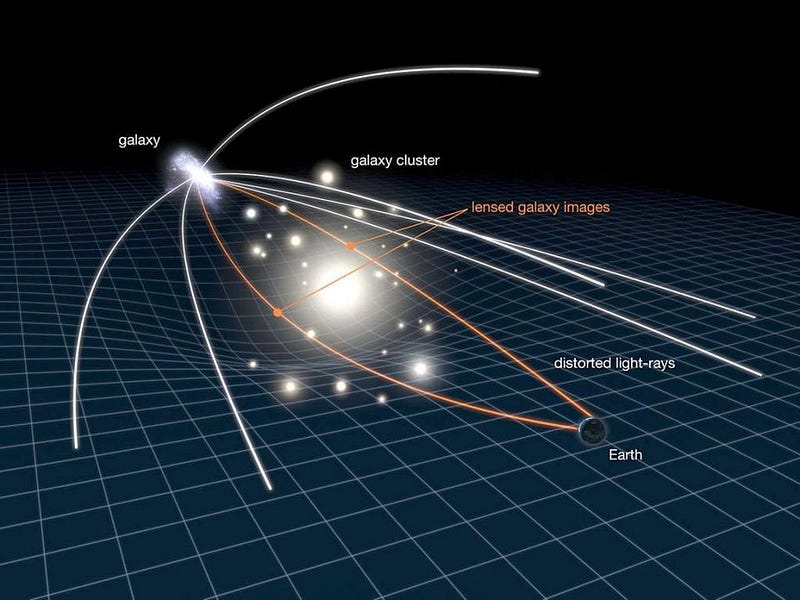
When we take the effects of gravitational lensing into account, along with the associated curvature of space due to Einstein’s relativity, this quasar becomes much more reasonable.
- Instead of 600 trillion times as luminous as our Sun, it’s only ~12 trillion times as luminous, in line with other quasars.
- Instead of a black hole that’s 10 billion times as massive as our Sun, unheard of at such early times, it should be only 0.8 billion times our Sun’s mass, consistent with other large supermassive black holes at those early stages.
- And instead of a star-formation rate that’s tens of thousands of times as great as our own galaxy, we reconstruct one that’s much more closely aligned with other young quasars: a few hundred to a few thousand solar masses worth of new stars per year.
In the future, larger-scale deep surveys should reveal more quasars at the fringes of powerful gravitational lenses. We should discover many more of these low-luminosity quasars at great distances, which are below the detection thresholds of our current observatories without a lensing enhancement. And for J0439 in particular, we fully expect that follow-up observations with ALMA will reveal how quickly the material around the quasar-powering black hole is moving, giving us a window into what its mass actually is.
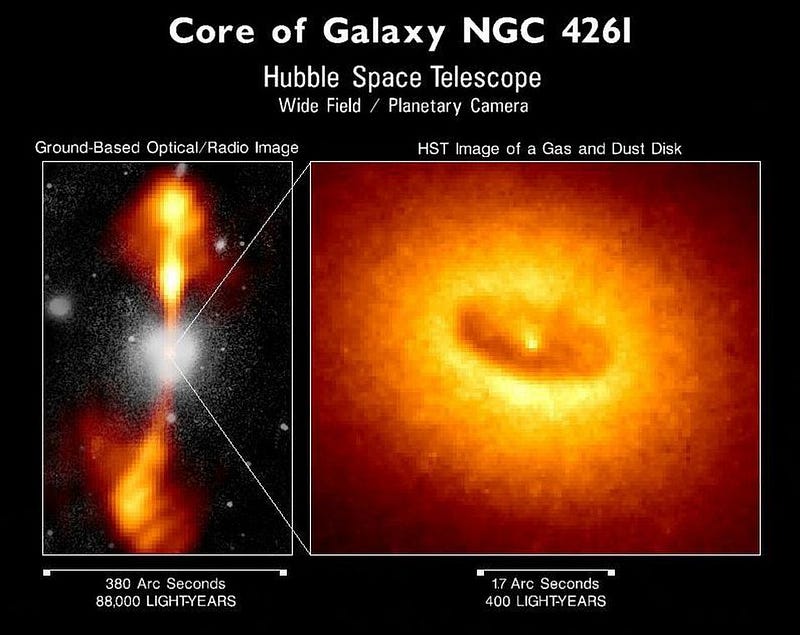
This new quasar is fascinating, but not for the reasons you might have heard. It’s not the brightest object near our cosmic dawn, but one of the faintest such objects discovered. It’s only because of the power of gravitational lensing, a chance alignment of an intervening galaxy, and the unique rules of Einstein’s relativity that we were able to find it at all.
We may have found the quasar with the largest apparent brightness in the early Universe, which is remarkable in and of itself. But our goal is to understand the Universe as it is, not as it appears to us. When we take that into account, this quasar is exactly in line with what we expect it to be. And that’s a fascinating story in and of itself, with no additional sensationalism necessary.
Ethan Siegel is the author of Beyond the Galaxy and Treknology. You can pre-order his third book, currently in development: the Encyclopaedia Cosmologica.





